

10-Minute Full Body Stretch Routine
Follow along with this 10-minute full body stretch routine at home. Add this full body stretching routine to your next active recovery day, or use it to cool down after a workout. These mobility exercises are designed to release low back pain, tight hips and tense muscles.
If you do my home workouts, you’re an athlete. That means you need to recover like an athlete.
Having a daily mobility or stretching routine is a great way to increase blood flow, reduce stiffness and improve your muscle recovery.
Recovery is debatably the most important part of a well-rounded fitness routine, yet it’s often skipped when we’re short on time.
I personally started focusing more on stretching, mobility and recovery after experiencing a meniscus tear and the following knee surgery.
That said, a dynamic stretching routine is important for anyone. Rest and recovery are vital to seeing the results you want from your daily workouts.

10-Minute Full Body Stretch Routine
Improve mobility, reduce risk of injury, and get better range of motion during workouts with this full body stretch routine.
This daily stretching routine is for anyone looking to:
- Gain Flexibility
- Increase Range of Motion
- Prevent Injury
I suggest incorporating stretch and mobility workouts like this one to your home workout plan 1-2 times per week to protect and maintain healthy joints and muscles.
Stretch Routine Equipment:
No equipment, just your bodyweight.
Stretch Routine Instructions:
Follow along with the guided Full Body Stretch Routine on YouTube, led by personal trainer Lindsey Bomgren.
The Stretch Routine Looks Like This:
- 15 Full Body Stretching Exercises
- We’ll flow through the routine, holding each upper body stretch and lower body stretch for 30 seconds or more.

Prefer to Watch On YouTube?
Workout Outline
- Plank Walk Out and Low Runner’s Lunge (Hip Stretch)
- Lizard Pose
- Cobra Pose
- Cat Cow Stretch
- Down Dog and Reach Backs
- Down Dog Hip Openers
- Crescent Lunge to Warrior One
- Humble Warrior and Chest Expansion
- Pyramid Pose (Hamstring Stretch)
- Down Dog to Table Top
- Puppy Dog Stretch and Frog Stretch
- Scorpion Pose
- Outer Glute Stretch and Spinal Twist
- Lying Plow Stretch (Low Back Stretch)
- Reverse Table Top
6 Full Body Stretches To Do Daily
Plank Walk Out And Low Runner’s Lunge (Hip Flexor Stretch)
Targets: Hamstrings, low back, shoulders, hips, hip flexors, glutes and core.
Note, you can hold the low lunge or hip flexor stretch for as long as 60 seconds per side.

How To Do A Plank Walk Out And Low Runner’s Lunge
- Start by standing with your feet hip-width apart; arms straight overhead.
- Hinge forward, pressing your hips directly back, soles of your feet remain flat on the mat if possible. Reach your fingertips to the mat and slowly walk out to a high plank position with your hands on the floor.
- Find a high plank, palms flat on the mat, shoulders stacked over wrists, core engaged, creating a straight line from your head to your heels.
- Exhale as you step your right foot outside of your right hand, planting it on the mat.
- Grounding through your left hand, open up towards the right, reaching your right elbow and right arm up towards the ceiling. Gaze follows fingertips.
- Return your right hand to the mat, then step back to high plank.
- Walk your hands back to meet your feet and stand tall.
- Then, repeat the plank walk out. This time, after finding a high plank, step your left foot outside your left hand. Open up towards the left, reaching your left elbow and left arm up towards the ceiling.
Cat Cow Stretch
Targets: Spine and low back.
The simple cat cow pose improves blood circulation between the vertebrae of your spine. Great for relieving back pain and stress.

How To Do A Cat Cow Stretch
- Start in a table top position (quadruped) on all fours. Shoulders are stacked over wrists and hips are stacked over knees.
- Find a neutral spine — think of the spine as a straight line connecting the shoulders to the hips. Keep the neck long by looking down and out.
- As you inhale, find an arch pose by curling your toes under and tilting your pelvis back so that your tailbone sticks up. Drop the belly down as you draw your navel in.
- Take your gaze gently up toward the ceiling. This is cow pose.
- On your exhale, round out for cat pose. Release the tops of your feet to the floor and tuck your tailbone.
- Draw your navel toward your spine and drop your head, gazing toward your navel.
- Repeat this sequence of arching and rounding out for 30-60 seconds.
Crescent Lunge To Warrior One With Chest Expansion
Targets: Hip flexors, quadriceps, hamstrings, chest, shoulders, torso and erector spinae muscles.
A great stretch for cyclists, runners or those who sit most of the day. Also great for improving balance and core strength.

How To Do A Crescent Lunge To Warrior One With Chest Expansion
- Start in a low lunge position, right foot forward, left foot back. Drop your back left knee towards the mat.
- Your right knee is directly over your right ankle and your front right thigh is parallel to the ground.
- Inhale and bring your arms above your head, keeping the arms and elbows in line with your ears.
- To deepen into the lunge for this hip flexor stretch, press firmly into your feet as you allow your hips to shift forward.
- Then, turn your back (left) foot out to find Warrior One. Back foot is now parallel (heel to arch alignment). Bring your arms out to a T position.
- Option to wrap your hands behind your back for a chest expansion.
- Hold for 30 to 60 seconds before switching sides.
Pyramid Pose (Hamstring Stretch)
Targets: Posterior chain (backside of the body) — hamstrings, low back, spine and hips.

How To Do A Pyramid Pose
- Start in a staggered stance, right foot forward, left foot back. Hips are square to the front.
- Bend forward to hinge at the hips and frame your front foot with your hands. Think less about how far you can reach down and more about how much you can push your hips back.
- Press through your front right heel. You should feel a stretch along the back of your right and left leg, specifically stretching your front right leg hamstring. Note, only stretch until there is mild to moderate tension on the back of the leg (hamstrings). Flexibility will improve over time in this hamstring stretch.
- Hold this position for 30-60 seconds.
- Switch your staggered stance, alternating to bring your back leg (left leg) forward and and repeat to stretch the left hamstring.
Puppy Dog Stretch
Targets: Spine, shoulders, upper back, neck, arms, chest and abdominal muscles.
The puppy pose is great for calming the body, relieving stress and anxiety. As well as releasing tension in you upper arms, shoulders, and neck. It’s similar to child’s pose but your hips stay high.
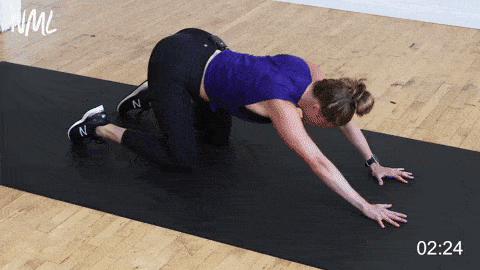
How To Do A Puppy Dog Stretch
- Start in a table top position (quadruped) on all fours. Shoulders are stacked over wrists and hips are stacked over knees (knees bent at 90 degrees).
- Then, walk your hands away from your body.
- Extend your hands as far out in front of your body as possible while keeping your hips high.
- Think about creating length from fingertips to tailbone.
- Hold this position for 60 seconds, lengthening from fingertips to tailbone with each exhale.
Reverse Table Top
Targets: Chest, shoulders, back, neck, arms, knees and hips.
Reverse table top pose, also called crab pose, opens the chest and stimulates the respiratory and endocrine systems.

How To Do A Reverse Table Top
- Begin seated on your mat, legs bent at 90 degrees, feet on the mat. Rest your hands behind you, shoulder-width distance apart; fingertips facing your butt.
- Press your heels into the floor, using your hamstrings and glutes to lift your hips off the ground. Your body should form a straight line from torso to knees, shoulders stacked directly over your wrists and knees stacked directly over your ankles.
- Hold this position for 30-60 seconds.
- Then, slowly lower your hips down to return to the starting position.
Full Body Stretch FAQs
Full body stretching is so important and has several benefits like: increases active range of motion (ROM), improves posture, prevents back pain, relieves stress, improves circulation, increases flexibility, prevents injury, decreases sore muscles and improves athletic performance. Strengthening and stretching specific muscle groups, promotes proper alignment, reduces musculoskeletal pain and improves your overall athletic performance.
You should stretch daily, with 2-3 longer full body stretching sessions a week. Having a daily stretching routine is a great way to increase blood flow and reduce stiffness. Having a 10-Minute Morning Stretch Routine after a prolonged period of inactivity (like after 8 hours of sleep) is a great way to wake up. Harvard Health says that healthy adults should aim for 2-3 longer stretching sessions a week, so that’s my personal goal when it comes to longer stretching sessions.
The two most common types of daily stretching include: dynamic and static stretches. Dynamic stretches are done BEFORE a workout as it helps get your muscles warmed up. Static stretches are stretches that you hold for 15-30 seconds and are done AFTER your workout to help loosen up tight muscles after exercise.
More Stretches
Stretch RoutinesPin this Full-Body Stretching Routine

This post includes affiliate links. I do make a small commission for products purchased using these links (at no additional cost to you). Thank you for supporting Nourish Move Love, making the content you see on this blog possible.















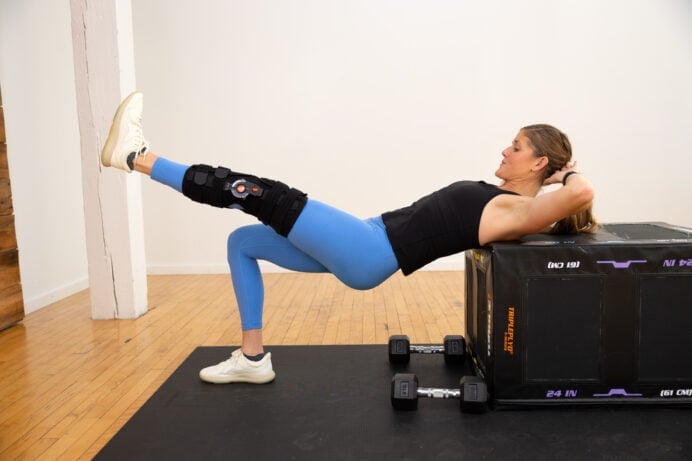


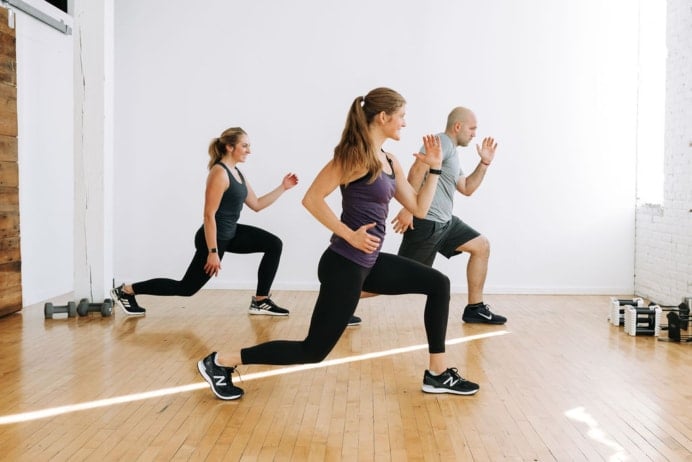


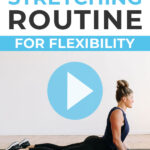

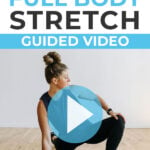










Love this stretch routine and have begun to incorporate it into my workouts at least 3 times a week. Have just completed my second 30 day workout plan of yours and find this a great way to love my muscles again after any of your training sessions. Loving the variety and even some of the ‘holy banana’ moments!
Hi Kerry! So glad you enjoyed this full body stretch; 3 times a week, you’re a rockstar! Way to stretch it out! And crushing the 30 day workout plans too! Keep up the great work! – Lindsey
I finally did this routine after seeing you post on Instagram. Thank you! You are so encouraging and energetic in your videos, and I appreciate your expertise as well. I think I now know how to get an effective stretch out of pyramid pose, after having done it for ages!
Nice work Sarah! Glad you gave this stretching routine a try — it feels so good (especially if you’re tight and sore)! Pyramid pose is SO GOOD for the hammies! And thank you for following along, I hope you keep coming back for more. -Lindsey
thank you so much for this post and this stretch routine!
So glad you like this stretching routine Stefanie! A great add-on to any workout or solid stretch routine on its own!
-Lindsey